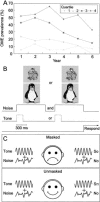Impaired binaural hearing in children produced by a threshold level of middle ear disease
- PMID: 12943367
- PMCID: PMC3202709
- DOI: 10.1007/s10162-002-3007-9
Impaired binaural hearing in children produced by a threshold level of middle ear disease
Abstract
Otitis media with effusion (OME), a form of middle ear disease, is the most common reason for young children both to visit their family doctor and to have surgery. Almost all children have at least a single episode of OME before their first birthday and annual incidence rates exceed 50% in each of the first five years. For most children, OME occurs infrequently, but about 10-15% of children have OME during more than half of their first six years. Middle ear effusions attenuate and delay sound, causing conductive sound distortion during the crucial years for language acquisition. The many studies of OME effects on language and other indices of development have produced mixed results. However, a consensus is emerging of mild language impairment in the preschool years, with subsequent performance, emotional, and behavioral difficulties. In addition to the peripheral hearing loss produced directly by the disease, binaural and other central auditory deficits can outlive the OME. It has been unclear which children are at risk of central impairment following OME, since the children studied have generally been recruited from otolaryngology clinics. Consequently, a detailed prospective history of the middle ear status of participants has not been available. By studying six-year-old children with a lifetime known history of OME, we show in this study that only those children with a cumulative OME experience of more than about half the time during the first five years consistently have residual impaired binaural hearing.
Figures



Similar articles
-
Clinical practice guideline: Otitis media with effusion.Otolaryngol Head Neck Surg. 2004 May;130(5 Suppl):S95-118. doi: 10.1016/j.otohns.2004.02.002. Otolaryngol Head Neck Surg. 2004. PMID: 15138413
-
Effects of otitis media with effusion on auditory temporal resolution.Int J Pediatr Otorhinolaryngol. 2005 Jun;69(6):757-69. doi: 10.1016/j.ijporl.2005.01.009. Epub 2005 Feb 23. Int J Pediatr Otorhinolaryngol. 2005. PMID: 15885328
-
Effects of otitis media with effusion (OME) on central auditory function.Int J Pediatr Otorhinolaryngol. 2003 Dec;67 Suppl 1:S63-7. doi: 10.1016/j.ijporl.2003.08.015. Int J Pediatr Otorhinolaryngol. 2003. PMID: 14662170
-
Otitis media, hearing loss, and language learning: controversies and current research.J Dev Behav Pediatr. 2004 Apr;25(2):110-22. doi: 10.1097/00004703-200404000-00007. J Dev Behav Pediatr. 2004. PMID: 15083134 Review.
-
Natural history of otitis media with effusion-related hearing loss in children under 12 years: a systematic review.Arch Dis Child. 2024 Dec 13;110(1):38-44. doi: 10.1136/archdischild-2024-327463. Arch Dis Child. 2024. PMID: 39299718
Cited by
-
Improving the Differential Diagnosis of Otitis Media With Effusion Using Wideband Acoustic Immittance.Ear Hear. 2021 Sep/Oct;42(5):1183-1194. doi: 10.1097/AUD.0000000000001037. Ear Hear. 2021. PMID: 33928915 Free PMC article.
-
Central auditory processing in teenagers with non-cholesteatomatous chronic otitis media.Braz J Otorhinolaryngol. 2020 Sep-Oct;86(5):568-578. doi: 10.1016/j.bjorl.2019.02.006. Epub 2019 Apr 23. Braz J Otorhinolaryngol. 2020. PMID: 31122883 Free PMC article.
-
Monaural deprivation disrupts development of binaural selectivity in auditory midbrain and cortex.Neuron. 2010 Mar 11;65(5):718-31. doi: 10.1016/j.neuron.2010.02.019. Neuron. 2010. PMID: 20223206 Free PMC article.
-
Developmental plasticity of spatial hearing following asymmetric hearing loss: context-dependent cue integration and its clinical implications.Front Syst Neurosci. 2013 Dec 27;7:123. doi: 10.3389/fnsys.2013.00123. Front Syst Neurosci. 2013. PMID: 24409125 Free PMC article. Review.
-
The conductive hearing loss due to an experimentally induced middle ear effusion alters the interaural level and time difference cues to sound location.J Assoc Res Otolaryngol. 2012 Oct;13(5):641-54. doi: 10.1007/s10162-012-0335-2. Epub 2012 May 31. J Assoc Res Otolaryngol. 2012. PMID: 22648382 Free PMC article.
References
-
- Besing JM, Koehnke J. A test of virtual auditory localization. Ear Hear. 1995;16:220–229. - PubMed
-
- Bluestone CD, Klein JO. Otitis Media in Infants and Children, 2nd ed. Philadelphia: W.B. Saunders; 1995.
-
- Bishop DVM. Uncommon understanding: Development and disorders of language comprehension in children. Hove, E. Sussex: Psychology Press; 1997.
Publication types
MeSH terms
LinkOut - more resources
Full Text Sources

